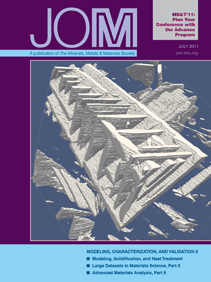VISIT THE
JOM COVER GALLERY
JOM
HOME PAGE
TABLES
OF CONTENTS
HTML-ENHANCED
ARTICLES
MATERIAL
MATTERS
CONSULTANTS
DIRECTORY
PROFESSIONAL PREFACE
SUBJECT
INDEXES
MEETINGS
CALENDAR
TECHNICAL
EMPHASIS CALENDAR
AUTHOR'S
KIT
AUTHOR
BIOGRAPHY/ABSTRACT SUBMISSION FORM
BOOK
REVIEW PROGRAM
ADVERTISING
INFORMATION
RESERVE
A CLASSIFIED
SUBSCRIPTIONS
SINGLE
ISSUE PURCHASES
|
|
I'll See You in Court—Overview of a Patent Infringement
Trial
Arnold B. Silverman
For those whose sole exposure to a trial of any type was through
television or the movies, what actually occurs in a patent infringement
trial can be enlightening and surprising. Because patent litigation
can be very time consuming, expensive, and uncertain as to the result,
it is generally initiated only after a thorough evaluation of the
case and reasonable efforts to resolve the matter amicably have failed.
If a patent owner concludes that a third party is infringing his or
her patent, a suit against the alleged infringer may be initiated
in a federal district court. Such an action would generally seek remedies
such as an injunction, which is a court order requiring the infringer
to terminate the objected-to activity, and other appropriate remedies
including damages. A second route to trial in a patent infringement
matter is through the declaratory judgment action. If one is accused
of patent infringement, one can initiate a suit against the patentee,
seeking to have the objected-to practice declared a non-infringing
activity and/or seeking to have the patent declared invalid.
Before a trial, a complaint is filed alleging the basis of the claim,and
requesting certain remedies. In response, an answer to the complaint
is filed, and, subsequently, discovery is initiated. This may include
depositions of individuals having factual knowledge relevant to the
case and, in some instances, experts; requests for production of documents;
requests for admission of facts, thereby eliminating the need to prove
the same at trial; and written questions, which are called interrogatories.
There is also an opportunity to make certain motions. Typically, the
judge who is handling the case conducts one or more conferences to
deal with matters that require court intervention prior to trial.
During the trial, each party is given the opportunity to present an
opening statement, summarizing the issues involved in the case and
what it hopes to establish.
The party that has initiated the suit, the plaintiff, presents its
case first. Apart from certain matters stipulated to by the parties,
most of the presentation involves live witnesses who are interrogated
initially by the party whose witness it is. The opposing counsel has
the opportunity to cross examine (i.e., ask questions of the witness
within the scope of the testimony originally given). Such cross examination
provides an opportunity for the other side to elicit additional information
from the witness, which may weaken the witness’s testimony.
As part of the interrogation of witnesses, various exhibits, such
as documents and physical objects, may be introduced into evidence
and are the subject of questions asked of the witness. The information
may be delivered to the court and jury by a witness discussing documents
or objects, or by film or computerized animation. Similarly, the
patent drawings, text, and patent claims may be the subject of large
boards on which the graphics and language of interest appear.
Two types of witnesses are generally involved in a patent case. First,
fact witnesses are there to testify regarding their knowledge of the
case. They are not permitted to render opinions. Expert witnesses,
on the other hand, have, by education and experience, expertise in
a particular field. Generally, other than through involvement in
the case, they do not have prior knowledge of the facts of the case.
These witnesses are permitted to provide opinions.
In patent infringement cases, it is fairly common to have a technical
expert who can testify as to the technical aspects of the patent in
question as well as previously known technology (“prior art”).
Depending upon the issues in the case, there also may be a patent
expert who, typically, would be an intellectual property lawyer specializing
in patent law. A damages expert who can testify as to the economic
impact of the infringement is also frequently involved.
During the course of the trial, the court frequently is asked to make
rulings as to matters involving procedure, rules of evidence, and
legalities. At the end of the trial, each party’s counsel makes
a presentation summarizing the case in a manner most favorable to
its client. After that, the judge or jury, under suitable instructions
from the judge, renders a decision on each issue to be determined
in the trial.
Among the challenges presented in trial presentation of a patent infringement
case is the need to make sure that the technology involved in the
invention is presented in a clear manner so that the jury and judge
will have an accurate understanding of the technology involved. In
addition, there must be a clear presentation regarding the patented
invention with particular emphasis on the patent claims, which define the property rights and the legal principles applicable to the
issues involved in the case.
Arnold B. Silverman is chair of the Intellectual
Property Department and a member of Eckert Seamans Cherin & Mellott,
LLC in Pittsburgh, Pennsylvania.
For more information, contact A.B. Silverman at Eckert
Seamans Cherin & Mellott, LLC, 600 Grant Street, 44th Floor, Pittsburgh,
Pennsylvania 15219; (412) 566-6000; fax (412) 566-6099; e-mail abs@escm.com.
|

